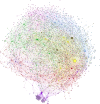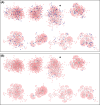Structure and function of gene regulatory networks associated with worker sterility in honeybees
- PMID: 26925214
- PMCID: PMC4755009
- DOI: 10.1002/ece3.1997
Structure and function of gene regulatory networks associated with worker sterility in honeybees
Abstract
A characteristic of eusocial bees is a reproductive division of labor in which one or a few queens monopolize reproduction, while her worker daughters take on reproductively altruistic roles within the colony. The evolution of worker reproductive altruism involves indirect selection for the coordinated expression of genes that regulate personal reproduction, but evidence for this type of selection remains elusive. In this study, we tested whether genes coexpressed under queen-induced worker sterility show evidence of adaptive organization within a model brain transcriptional regulatory network (TRN). If so, this structured pattern would imply that indirect selection on nonreproductive workers has influenced the functional organization of genes within the network, specifically to regulate the expression of sterility. We found that literature-curated sets of candidate genes for sterility, ranging in size from 18 to 267, show strong evidence of clustering within the three-dimensional space of the TRN. This finding suggests that our candidate sets of genes for sterility form functional modules within the living bee brain's TRN. Moreover, these same gene sets colocate to a single, albeit large, region of the TRN's topology. This spatially organized and convergent pattern contrasts with a null expectation for functionally unrelated genes to be haphazardly distributed throughout the network. Our meta-genomic analysis therefore provides first evidence for a truly "social transcriptome" that may regulate the conditional expression of honeybee worker sterility.
Keywords: Gene regulation; RNA profiling; indirect selection; insect sociobiology; meta‐analysis; microarrays; social behavior.
Figures



References
-
- Abouheif, E. 2004. A framework for studying the evolution of gene networks underlying polyphenism: insights from winged and wingless ant castes Pp. 125–137 in Hall B. K., Pearson R. D. and Muller G. B., eds. Environment, development, and evolution: toward a synthesis. MIT Press, Massachusetts.
-
- Backx, A. G. , Guzmán‐Novoa E., and Thompson G. J.. 2012. Factors affecting ovary activation in honeybee workers: a meta‐analysis. Insectes Soc. 59:381–388.
-
- Bastian, M. , Heymann S., and Jacomy M. 2009. Gephi: an open source software for exploring and manipulating networks. International AAAI Conference on Weblogs and Social Media, 8: 361–362. Available at: http://www.aaai.org/ocs/index.php/ICWSM/09/paper/view/154/.
LinkOut - more resources
Full Text Sources
Other Literature Sources

